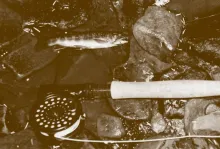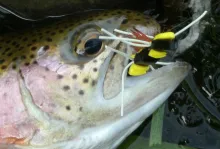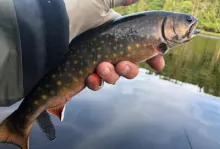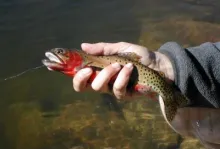More than a sport fish, the brook trout has, throughout its range, become a barometer for the environmental health of North American rivers and streams. It seems fitting in this context that a little fish plays such a big role.
The Commonwealth of Pennsylvania adopted the brook trout as its official fish in 1972, and it is no wonder why these native swimmers are so special to my home Keystone State . More than a sport fish, the brook trout has, throughout its range, become a barometer for the environmental health of North American rivers and streams. It seems fitting in this context that a little fish plays such a big role.
An act of the Pennsylvania legislature appropriated this fish for its own, but America 's most famous native char is truly an international fish. Transplanted to the American West in the Nineteenth century, where it thrives today, and reaching its largest physical dimensions in the Canadian province of Labrador , the brook trout can honestly be claimed by all the home waters wherein it swims. Still, it is the secluded and diminutive mountain streams of the Smokies, the Appalachians, and the rolling hills of New England that historically best give expression to the allure and pursuit of this little fish without reservation or size chauvinism.

Old Man, Young Fisher
My own introduction to this fantastic fish was actually made in New Hampshire during a high school summer vacation. My family and I spent one month of June exploring wild New England, and one of our stops was New Hampshire’s Franconia Notch State Park, where we spent a few days camped under the watchful gaze of the Old Man of the Mountain. This famous outcrop of five granite ledges, when viewed in profile, resembled a human face. More than a tourist attraction, the Old Man became an icon of regional pride, one celebrated by Nathaniel Hawthorne and Daniel Webster, and one honored by the U.S. Mint, which selected him for the reverse of the New Hampshire state quarter. (Sadly, this natural wonder collapsed during a long storm and thick fog on May 3, 2003.)
My first brook trout tale took place twenty years earlier, in 1983, when the Old Man was still smiling down upon budding outdoorsmen like me. I woke up in my tent on the first morning and shivered, both from the excitement of fly-fishing new water and the fine layer of frost that had settled overnight. I distinctly remember standing beside the breakfast fire and savoring that first steaming cup of camp coffee. (I developed my lifelong love for the bittersweet brown bean at a very young age.)
Profile Lake , which lay directly below the Old Man, resembled a cereal bowl of cold, clear water. Its sand and pebble bottom sloped gently into its opaque jade depths, which contained just the occasional frond of submerged shoreline vegetation best described by me then as “water grass.” Later on, a bit of education in aquatic botany revealed I was not so far off the mark: common waterweed and pondweed are the accepted popular names for these plants.
The backdrop standing tall before me was quite a change from the warmwater impoundments and ponds I was used to fishing in Pennsylvania so I eagerly set out to explore. I hiked around to the far side of the lake that bordered the base of the mountain. I sought out the most secluded spots, even at that age, not so much for solitude as for access to the less-pressured water. There were inviting bankside boulders along the far side, and after I scrambled up the first one, I gazed down at water that reminded me of the fishbowl glass top of a living room table. Beneath the “glass” was a lakebed of variegated colors and patterns and, I hoped, fish!
I was not disappointed. I dapped a Royal Coachman onto the surface of the lake, skated it for a foot or two, and a dark little missile shot up from the bottom to meet it. I thought “sunfish” but knew better. The frisky fish at the end of my tippet was just as small and just as colorful, but this was a trout, or more precisely, a char: THE char — Brook Trout — Salvelinus fontinalis.
That lake turned out to be chock full of native brookies in the seven- to ten-inch class. I caught and released at least two dozen during our stay. My little collection of Royal Coachman and White Miller in sizes 12 through 16 worked miracles, and I even lured one or two on a very old family specimen of a very old wet fly pattern — the Silver Doctor.

Brook Trout, Reborn
My re-acquaintance with this fish was made twenty-one years later, by chance, during a simple day of adventure and solitude in Penn’s Woods. I had made plans for a week-long fishing vacation with my eldest fishing buddy, my father, to celebrate his 60th birthday, and I did spend many of those June afternoons with him, learning to use his new boat on the large lakes of Western Pennsylvania, yet the first Sunday of the trip turned out to be the magical day. I had left my adopted home of Philadelphia behind and found myself heading north and west in his forest green pickup toward Venango County . We had agreed that far too many boats would be on the water during a sunny Sunday in early summer, so we decided to spend a day along a remote mountain stream —
“Where to?”
“Oil Creek.”
I knew enough regional history to know not to be put off by the flow’s formal name. Pennsylvania ’s Venango County is green, steep country located along the western slope of the Commonwealth’s portion of the Appalachian range. Irony alone is responsible for the region’s black past, specifically the development of the oil industry that was born here in the middle of the nineteenth century. Colonel Edmund Drake’s famous well near Titusville became, in 1859, the derrick that gave birth to commercial production and the world’s now omnipresent oil industry. Samuel Van Syckel, an oil buyer and shipper in the Oil Creek area, followed with his pipeline, the first major one of its kind, in 1865. Like most histories of industrial development, there was a time when portions of this pristine area suffered degradation from water pollution, yet the constant flow of cool springs and the migration of the oil industry to other regions of the United States saved these parts from permanent scarring. These waters have been reborn.
We arrived along the forested banks of Oil Creek mid-morning. We parked by a small bridge, collected our equipment, and began to hike in along the angler’s footpath beside an old railroad track that parallels the eastern side of the creek. Two doe followed our initial progress from the opposite bank. One would pause to sip while the other kept a careful eye on us. The other side of the track was bordered by a high cliff of layered shale covered by an earth-toned patchwork of lichens, moss, and small spring flows. The sound of flowing water, summer breezes, and songbirds provided the melody above the steady rhythm of crunching gravel beneath our four feet.
The plan was to hike upstream to where our map showed an island that divided the creek into two smaller channels. We had chosen to pass over the two delayed-harvest, artificial-lure only sections located at the north and south end of the stream’s flow within Oil Creek State Park . These popular areas, which look on a map like big trout bookends, provide consistent fly-fishing for trophy browns, but the potential for far less solitude.
I was intrigued by the fact that over a dozen small tributaries flow into the creek within the park, and the map’s field guide stated that several of these runs held populations of brook trout. When we reached the point where the first unnamed tributary met the creek, my buddy turned down toward the main stem to chase his beloved lunker browns, and I turned up toward the tributary to explore the possibility of wild little brookies. I had a strong desire to match hatches and wits with a fourteen-inch brown trout, but the desire to fly fish for the commonwealth’s bejeweled fish — brook trout — was at least fourteen times stronger!
The first fifty yards of this brook consisted of a living wall of brush, raspberry thorns, and thick-stalked marsh plants; a challenging passage that rewarded me when it opened up onto a landscape I had before only read about: a narrow, rocky rivulet bordered by steep, sun-dappled hillsides full of hemlock trees, mountain laurel, waist-high ferns, pale mushrooms, and smooth boulders covered with brown needles and deep green moss. The stream itself was only as wide as a city sidewalk in most spots, a foot or two deep at most, cold, glass clear, and as I as I found when I quenched my thirst from its flow, delicious.
This was pocket water, and like most runs of this type, I was to find it held only five or six fishable pools along the mile-long stretch of its course. These conditions make for opportunistic trout, so I chose to work with one of my own attractor patterns: a size 14 Wet Wool Adams; another basic fly that uses gray knitting wool for the body and pheasant tail fibers for the hackle. The general shape and color approximate the Adams dry fly, thus the name. Other standard flies such as the Olive Stimulator, Adams Parachute, American Pheasant Tail nymph, and small, unweighted, Muddler Minnow streamers are all one need to carry in a well-rounded mountain brook trout fly wallet.
I knelt down on a stone when I reached the first promising pool. This was a fitting posture, as I was spending Sunday within a fly-fishing church, the hemlocks receding up both sides of the run like the columns of a temple. This is always the most successful stature to reach those comfortable pools held in place by a mouse maze of broken branches or overhanging roots. Chances are 50-50 that any hooked brook trout will break water on the angler’s side of the log, and the low profile provides the necessary stealth. Tiny brook trout are very vulnerable to raccoons and other predators in these shallow waters, which make the fish particularly aware of any streamside sound that indicates movement.
Casting was a challenging exercise in this tight environment. Thin evergreen branches and the recalcitrant leaves of ferns hold hard onto a miscast fly. A 4-weight, 7 1/2 foot rod would be the ideal outfit to carry, but I made good with what I had with me: an 8 1/2 foot 5-weight. I found short, light, upstream roll casts to be the most effective and successful. The challenge in these situations is to keep focused on the fishing and do one’s best to make the fly roll down the tiny waterfalls that feed these pockets.
I was in luck and rewarded on this day. I caught and released a Pennsylvania limit of five fish and several more shook the hook in between. What fun these tiny trout provided! Each one rocketed out from under a partially submerged root or rock, smacked the little floating fly, and then gave my rod a respectable bend. These fish averaged a modest six or seven inches in length, yet were the most gorgeous fish I have ever held: deep purple flanks, crimson spots bordered by blue sky blue, and brick red fins lined with black and white.
An evening quality of half-light descended a few hours earlier within that narrow valley, and I carried no torch. Time and experience told me the banks flanking the creek bed provided the most direct route out of the woods. I followed downstream along a perimeter of petite club mosses and found the return trip shorter. Downhill hiking — and no more casting — saved time.
I made my way through the thickly overgrown confluence and up to the rail bed, where I followed the tracks south to our base beside the bridge. The trek back from there was accompanied by the ghosts of those folks who rest in the park’s scattered, overgrown graveyards, and the echoes of the old oil boom days could be felt, if not heard, within the breezes giving voice through the tree branches. Wild raspberries, accompanied by the evening songs of thrushes, provided a pick-me-up on the way to the pickup.

The Mountain Brook Trout Kit
Basic Rig
3- to 5-weight fly rod and reel outfitted with floating line.
Fly Box
1) Adams Parachute, size 10-16
2) American Pheasant Tail Nymph, size 10-16
3) Muddler Minnow, size 10-16
4) Olive Stimulator, size 10-16
5) Wet Wool Adams , size 10-16
Other Necessities
Hemostats, insect repellent, non-toxic split shot, polarized sunglasses, small landing net.

- Log in to post comments











